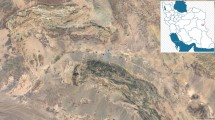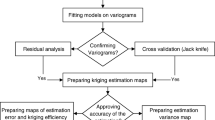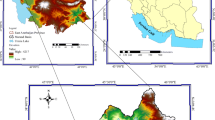Abstract
This research uses multivariate statistics to develop the unique dependent variables as inputs for geostatistical analysis in groundwater modeling. The chief aim of the study is to understand if simulation methods are sufficiently accurate to use for groundwater in different regions with various databases. First, factor analysis produced two factors presenting 81.38% and 13.92% of variability for Factor 1 and Factor 2, respectively. Then, the geostatistical estimation based on the ordinary kriging technique was applied to map the factors and prepared the interpolation, estimation variance, and kriging efficiency maps. Kriging is a smoothed interpolation; therefore, the maps based on the sequential Gaussian simulation, and turning band algorithm, were prepared to solve the kriging smoothing in GS+ software and MATLAB software, respectively. Eventually, histograms and variogram of reproductions, obtained from different realizations, were compiled by sequential Gaussian simulation and turning band simulation methods. Results showed that simulation approaches revealed less smoothed synthetic data. The sequential Gaussian simulation is proposed to map the attributes in small scales (large area). Also, the turning band simulation is recommended to apply in large-scale studies. Furthermore, this research proves the ability of the turning band algorithm as an innovative technique in evaluating and modeling the groundwater, which has not been observed so far in other studies in a wide range. This algorithm is proven to improve the quality of estimations and produce maps more accurately.














Similar content being viewed by others
Data availability
Not applicable.
Code availability
Not applicable.
References
Adhikary PP, Dash CJ, Chandrasekharan H, Rajput TBS, Dubey SK (2012) Evaluation of groundwater quality for irrigation and drinking using GIS and geostatistics in a peri-urban area of Delhi, India. Arab J Geosci 5:1423–1434. https://doi.org/10.1007/s12517-011-0330-7
Adimalla N, Vasa SK, Li P (2018) Evaluation of groundwater quality, Peddavagu in Central Telangana (PCT), South India: an insight of controlling factors of fluoride enrichment. Model Earth Syst Environ 4:841–852. https://doi.org/10.1007/s40808-018-0443-z
Arslan H (2012) Spatial and temporal mapping of groundwater salinity using ordinary kriging and indicator kriging: the case of Bafra Plain, Turkey. Agric Water Manag 113:57–63. https://doi.org/10.1016/j.agwat.2012.06.015
Asghari O, Soltani F, Amnieh HB (2009) The comparison between sequential Gaussian simulation (SGS) of Choghart ore deposit and geostatistical estimation through ordinary kriging. Aust J Basic Appl Sci 3:330–341
Barca E, Passarella G (2008) Spatial evaluation of the risk of groundwater quality degradation. A comparison between disjunctive kriging and geostatistical simulation. Environ Monit Assess 137:261–273
Bárdossy A, Kundzewicz ZW (1990) Geostatistical methods for detection of outliers in groundwater quality spatial fields. J Hydrol 115:343–359. https://doi.org/10.1016/0022-1694(90)90213-H
Bastante FG, Ordóñez C, Taboada J, Matías JM (2008) Comparison of indicator kriging, conditional indicator simulation and multiple-point statistics used to model slate deposits. Eng Geol 98:50–59. https://doi.org/10.1016/j.enggeo.2008.01.006
Boyacioglu H, Boyacioglu H (2008) Water pollution sources assessment by multivariate statistical methods in the Tahtali Basin, Turkey. Environ Geol 54:275–282. https://doi.org/10.1007/s00254-007-0815-6
Chakrabortty R, Pal SC, Malik S, Das B (2018) Modeling and mapping of groundwater potentiality zones using AHP and GIS technique: a case study of Raniganj Block, Paschim Bardhaman, West Bengal. Model Earth Syst Environ 4:1085–1110. https://doi.org/10.1007/s40808-018-0471-8
Chen K, Jiao JJ, Huang J, Huang R (2007) Multivariate statistical evaluation of trace elements in groundwater in a coastal area in Shenzhen, China. Environ Pollut 147:771–780. https://doi.org/10.1016/j.envpol.2006.09.002
Chen M, Price RM, Yamashita Y, Jaffé R (2010) Comparative study of dissolved organic matter from groundwater and surface water in the Florida coastal Everglades using multi-dimensional spectrofluorometry combined with multivariate statistics. Appl Geochem 25:872–880. https://doi.org/10.1016/j.apgeochem.2010.03.005
Cinnirella S, Buttafuoco G, Pirrone N (2005) Stochastic analysis to assess the spatial distribution of groundwater nitrate concentrations in the Po catchment (Italy). Environ Pollut 133:569–580. https://doi.org/10.1016/j.envpol.2004.06.020
Cloutier V, Lefebvre R, Therrien R, Savard MM (2008) Multivariate statistical analysis of geochemical data as indicative of the hydrogeochemical evolution of groundwater in a sedimentary rock aquifer system. J Hydrol 353:294–313. https://doi.org/10.1016/j.jhydrol.2008.02.015
Deepa S, Venkateswaran S, Ayyandurai R, Kannan R, Prabhu MV (2016) Groundwater recharge potential zones mapping in upper Manimuktha Sub basin Vellar river Tamil Nadu India using GIS and remote sensing techniques. Model Earth Syst Environ 2:1–13. https://doi.org/10.1007/s40808-016-0192-9
Desbarats AJ, Logan CE, Hinton MJ, Sharpe DR (2002) On the kriging of water table elevations using collateral information from a digital elevation model. J Hydrol 255:25–38
Deutsch CV, Journel AG (1999) GSLIB: geostatistical software library and user’s guide, 2nd edn. Oxford University Press, New York, pp 83–108. https://doi.org/10.1017/S0016756899531774
Emery X, Lantuéjoul C (2006) Tbsim: A computer program for conditional simulation of three-dimensional Gaussian random fields via the turning bands method. Comput Geosci 32:1615–1628
Ersoy A, Yunsel TY, Cetin M (2004) Characterization of land contaminated by heavy metal mining using geostatistical methods. Arch Environ Contam Toxicol 46:162–175. https://doi.org/10.1007/s00244-003-2269-5
Esfahani NM, Asghari O (2013) Fault detection in 3D by sequential Gaussian simulation of Rock Quality Designation (RQD). Arab J Geosci 6:3737–3747. https://doi.org/10.1007/s12517-012-0633-3
Finke PA, Brus DJ, Bierkens MFP, Hoogland T, Knotters M, De Vries F (2004) Mapping groundwater dynamics using multiple sources of exhaustive high-resolution data. J Geoder 123:23–39. https://doi.org/10.1016/j.geoderma.2004.01.025
Gaus I, Kinniburgh DG, Talbot JC, Webster R (2003) Geostatistical analysis of arsenic concentration in groundwater in Bangladesh using disjunctive kriging. J Environ Geol 44:939–948. https://doi.org/10.1007/s00254-003-0837-7
Ghobadi MH, Fereidooni D (2012) Seismic hazard assessment of the city of Hamedan and its vicinity, west of Iran. J Nat Hazards 63:1025–1038. https://doi.org/10.1007/s11069-012-0203-8
Güler C, Kurt MA, Alpaslan M, Akbulut C (2012) Assessment of the impact of anthropogenic activities on the groundwater hydrology and chemistry in Tarsus coastal plain (Mersin, SE Turkey) using fuzzy clustering, multivariate statistics, and GIS techniques. J Hydrol 414:435–451. https://doi.org/10.1016/j.jhydrol.2011.11.021
Heidari M, Khanlari GR, Beydokhti AT, Momeni AA (2011) The formation of cover-collapse sinkholes in North of Hamedan, Iran. J Geomorphol 132:76–86. https://doi.org/10.1016/j.geomorph.2011.04.025
Hu K, Huang Y, Li H, Li B, Chen D, White RE (2005) Spatial variability of shallow groundwater level, electrical conductivity, and nitrate concentration, and risk assessment of nitrate contamination in North China Plain. Environ Int 31:896–903. https://doi.org/10.1016/j.envint.2005.05.028
Huysmans M, Dassargues A (2009) Application of multiple-point geostatistics on modeling groundwater flow and transport in a cross-bedded aquifer (Belgium). Hydrogeol J 17:1901–1911. https://doi.org/10.1007/s10040-009-0495-2
Jalali M, Karami S, Fatehi Marj A (2016) Geostatistical evaluation of spatial variation related to groundwater quality database: case study for Arak Plain Aquifer, Iran. Environ Model Assess 21:707–719. https://doi.org/10.1007/s10666-016-9506-6
Jalali M, Karami S, Marj AF (2019) On the problem of the spatial distribution delineation of the groundwater quality indicators via multivariate statistical and geostatistical approaches. Environ Monit Assess 191:1–18. https://doi.org/10.1007/s10661-019-7432-1
Jang CS (2013) Use of multivariate indicator kriging methods for assessing groundwater contamination extents for irrigation. Environ Monit Assess 185:4049–4061. https://doi.org/10.1007/s10661-012-2848-x
Jothibasu A, Anbazhagan S (2016) Modeling groundwater probability index in Ponnaiyar River basin of South India using analytic hierarchy process. Model Earth Syst Environ 2:1–14. https://doi.org/10.1007/s40808-016-0174-y
Journel AG (1989) Fundamentals of geostatistics in five lessons. American Geophysical Union, Washington, pp 1–40
Journel AG, Huijbregts CJ (1978) Mining geostatistics. Academic Press, London
Karami S, Madani H, Katibeh H, Marj AF (2018) Assessment and modeling of the groundwater hydrogeochemical quality parameters via geostatistical approaches. Appl Water Sci 8:1–13. https://doi.org/10.1007/s13201-018-0641-x
Karami S, Jalali M, Katibeh H, Fatehi Marj A (2020) Groundwater hydrogeochemical assessment using advanced spatial statistics methods: a case study of Tehran-Karaj plain aquifer, Iran. Arab J Geosci 13:1–16. https://doi.org/10.1007/s12517-019-5047-z
Lee JJ, Jang CS, Wang SW, Liu CW (2007) Evaluation of potential health risk of arsenic-affected groundwater using indicator kriging and dose-response model. Sci Total Environ 384:151–162. https://doi.org/10.1016/j.scitotenv.2007.06.021
Lee JJ, Liu CW, Jang CS, Liang CP (2008) Zonal management of multi-purpose use of water from arsenic-affected aquifers by using a multi-variable indicator kriging approach. J Hydrol 359:260–273. https://doi.org/10.1016/j.jhydrol.2008.07.015
Lin YP (2002) Multivariate geostatistical methods to identify and map spatial variations of soil heavy metals. Environ Geol 42:1–10. https://doi.org/10.1007/s00254-002-0523-1
Lyon SW, Lembo AJ Jr, Walter MT, Steenhuis TS (2006) Defining probability of saturation with indicator kriging on hard and soft data. Adv Water Resour 29:181–193. https://doi.org/10.1016/j.advwatres.2005.02.012
Machiwal D, Cloutier V, Güler C, Kazakis N (2018) A review of GIS-integrated statistical techniques for groundwater quality evaluation and protection. Environ Earth Sci 77:1–30. https://doi.org/10.1007/s12665-018-7872-x
Masoud AA (2014) Groundwater quality assessment of the shallow aquifers west of the Nile Delta (Egypt) using multivariate statistical and geostatistical techniques. J Afr Earth Sci 95:123–137. https://doi.org/10.1016/j.jafrearsci.2014.03.006
Mendes MP, Ribeiro L (2010) Nitrate probability mapping in the northern aquifer alluvial system of the river Tagus (Portugal) using Disjunctive Kriging. Sci Total Environ 408:1021–1034. https://doi.org/10.1016/j.scitotenv.2009.10.069
Momejian N, Najm MA, Alameddine I, El-Fadel M (2019) Groundwater vulnerability modeling to assess seawater intrusion: a methodological comparison with geospatial interpolation. Water Resour Manag 33:1039–1052. https://doi.org/10.1007/s11269-018-2165-4
Mouser PJ, Rizzo DM, Röling WF, Van Breukelen BM (2005) A multivariate statistical approach to spatial representation of groundwater contamination using hydrochemistry and microbial community profiles. Environ Sci Technol 39:7551–7559. https://doi.org/10.1021/es0502627
Muangthong S, Shrestha S (2015) Assessment of surface water quality using multivariate statistical techniques: the case study of the Nampong River and Songkhram River, Thailand. Environ Monit Assess 187:1–12. https://doi.org/10.1007/s10661-015-4774-1
Ouyang Y, Nkedi-Kizza P, Wu QT, Shinde D, Huang CH (2006) Assessment of seasonal variations in surface water quality. Water Res 40:3800–3810. https://doi.org/10.1016/j.watres.2006.08.030
Papadopoulou MP, Varouchakis EA, Karatzas GP (2009) Simulation of complex aquifer behavior using numerical and geostatistical methodologies. Desalination 237:42–53
Ramazi H, Jalali M (2015) Contribution of geophysical inversion theory and geostatistical simulation to determine geoelectrical anomalies. Stud Geophys Geod 59:97–112. https://doi.org/10.1007/s11200-013-0772-3
Rossi ME, Deutsch CV (2013) Mineral resource estimation. Springer Science and Business Media
Sağlam M, Dengiz O, Saygın F (2015) Assessment of horizontal and vertical variabilities of soil quality using multivariate statistics and geostatistical methods. Commun Soil Sci Plant Anal 46:1677–1697. https://doi.org/10.1080/00103624.2015.1045596
Salari M, Rakhshandehroo G, Ehetshami M (2017) Investigating the spatial variability of some important groundwater quality factors based on the geostatistical simulation (case study: Shiraz plain). Desalin Water Treat 65:163–174. https://doi.org/10.5004/dwt.2017.20262
Saranya T, Saravanan S (2020) Groundwater potential zone mapping using analytical hierarchy process (AHP) and GIS for Kancheepuram District, Tamilnadu, India. Model Earth Syst Environ 25:1–18. https://doi.org/10.1007/s40808-020-00744-7
Seyedmohammadi J, Esmaeelnejad L, Shabanpour M (2016) Spatial variation modelling of groundwater electrical conductivity using geostatistics and GIS. Model Earth Syst Environ 2:1–10. https://doi.org/10.1007/s40808-016-0226-3
Snowden DV (2001) Practical interpretation of mineral resource and ore reserve classification guidelines. Mineral Resource and Ore Reserve Estimation. The AusIMM Guide to Good Practice, pp 643–652
Soltani F, Afzal P, Asghari O (2014) Delineation of alteration zones based on Sequential Gaussian Simulation and concentration–volume fractal modeling in the hypogene zone of Sungun copper deposit, NW Iran. J Geochem Explor 140:64–76. https://doi.org/10.1016/j.gexplo.2014.02.007
Theodossiou N, Latinopoulos P (2006) Evaluation and optimization of groundwater observation networks using the Kriging methodology. Environ Model Softw 21:991–1000. https://doi.org/10.1016/j.envsoft.2005.05.001
Torcal F, Posadas AM, Chica M, Serrano I (1999) Application of conditional geostatistical simulation to calculate the probability of occurrence of earthquakes belonging to a seismic series. Geophys J Int 139:703–725. https://doi.org/10.1046/j.1365-246x.1999.00972.x
Wang Y, Wang P, Bai Y, Tian Z, Li J, Shao X, Mustavich LF, Li BL (2013) Assessment of surface water quality via multivariate statistical techniques: a case study of the Songhua River Harbin region, China. J Hydroenviron Res 7:30–40. https://doi.org/10.1016/j.jher.2012.10.003
Webster R, Oliver MA (2007) Geostatistics for environmental scientists, 2nd edn. Wiley, Brisbane, pp 225–226
Yeh MS, Lin YP, Chang LC (2006) Designing an optimal multivariate geostatistical groundwater quality monitoring network using factorial kriging and genetic algorithms. Environ Geol 50:101–121. https://doi.org/10.1007/s00254-006-0190-8
Acknowledgements
Special gratitude goes out to Iran Water Resources Management Company for collecting, analyzing, and providing the data. Also, we appreciate the anonymous reviewers for professional reviewing that improves the scientific quality of the paper. Herby, we are grateful to the editorial board of the Journal of Modeling Earth Systems and Environment for their consideration.
Funding
The authors did not receive support from any organization for the submitted work.
Author information
Authors and Affiliations
Contributions
We confirm that the manuscript has been prepared by all authors. Study concept and design: MJ. Acquisition of data: AFM. Analysis and interpretation of data: SK, MJ and AK. Drafting of the manuscript: SK. Critical revision of the manuscript for important intellectual content: SK and AK. Statistical analysis: SK and MJ. Administrative, technical, and material support: MJ. Study supervision: HK.
Corresponding author
Ethics declarations
Conflict of interest
The authors declare that they have no conflict of interest.
Ethics approval
The manuscript has been only submitted to this journal at this time. The submitted work is original and has not been published elsewhere in any form or language (partially or fully). A single study has not been split up into several parts to increase the quantity of submissions and submitted to various journals or one journal over time. Results have been presented honestly and without fabrication, falsification, or inappropriate data manipulation (including image-based manipulation). Authors have adhered to discipline-specific rules for acquiring, selecting and processing data. No data, text, or theories by others have been presented as if they were the author’s own (‘plagiarism’). Proper acknowledgments to other works have been given.
Consent to participate
All authors confirm their consent to participate.
Consent for publication
All authors confirm their consent to publish the manuscript.
Additional information
Publisher's Note
Springer Nature remains neutral with regard to jurisdictional claims in published maps and institutional affiliations.
Rights and permissions
About this article
Cite this article
Karami, S., Jalali, M., Karami, A. et al. Evaluating and modeling the groundwater in Hamedan plain aquifer, Iran, using the linear geostatistical estimation, sequential Gaussian simulation, and turning band simulation approaches. Model. Earth Syst. Environ. 8, 3555–3576 (2022). https://doi.org/10.1007/s40808-021-01295-1
Received:
Accepted:
Published:
Issue Date:
DOI: https://doi.org/10.1007/s40808-021-01295-1




